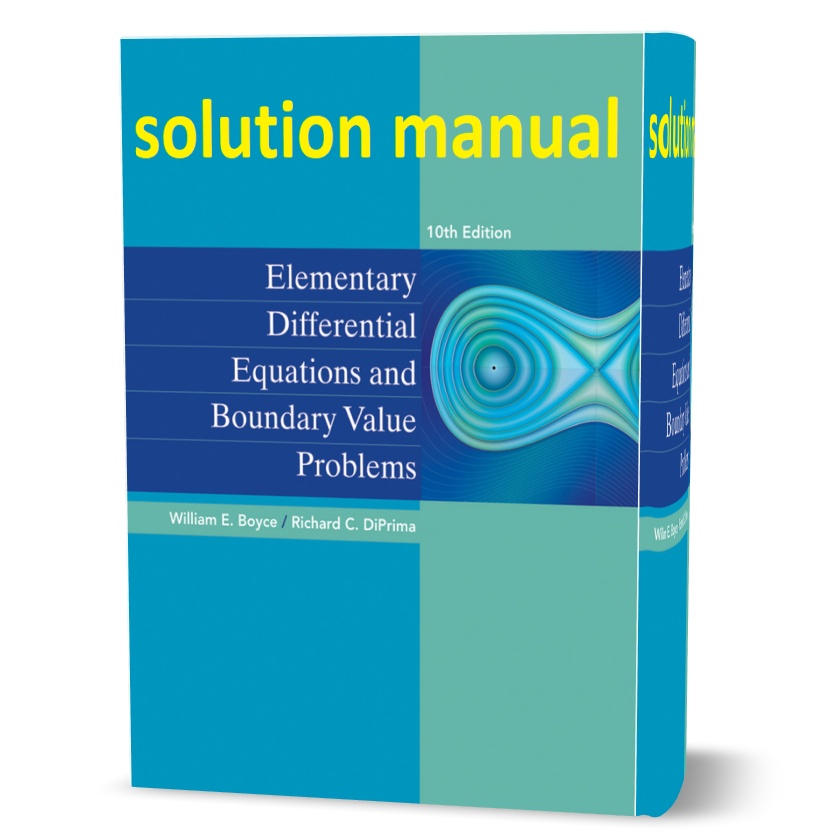Elementary differential equations and boundary value problems 10th edition student solutions manual pdf
Original price was: $35.00.$24.00Current price is: $24.00.
Published: Wiley 2012
Edition: 10th
Pages: 575
Type: pdf
Size: 26MB
Content: This File includes Chapters 1 to 11 questions answers . Very few questions did not answered in this file. to see the each chapter answered problem number, click here [ answered questions]
Sample: Solution sample file
Instantly Download After Payment
- Description
- Reviews (0)
Description
Description
This Download free Elementary differential equations and boundary value problems William Boyce 10th edition student solutions manual pdf edition, like its predicters, is written from the viewpoint of the applied mathematician, whose interest in differential equations may he sometimes quite theoretical, sometimes intensely practical, and often somewhere in between. We have sought to combine a sound and accurate (hut not abstract) exposition of the elementary theory of differential equations with considerable material on methods of solution, analysis, and approximation that have proved useful in a wide variety of applications. The book is written primarily for undergraduate students of mathematics, science, or engineering, who typically take a course on differential equations during their first or second year of study. for more ebook solutions click here.
Elementary differential equations and boundary value problems 10th edition student solutions manual pdf
The main Download free Elementary differential equations and boundary value problems William Boyce 10th edition student solutions manual pdf prerequisite for reading the book is a working knowledge of calculus. gained from a normal two- or three-semester course sequence or its equivalent. Some familiarity with matrices will also be helpful in the chapters on systems of differential equations. To be widely useful, a textbook must be adaptable to a variety of instructional strategies. This implies at least two things. First, instructors should have maximum flexibility to choose both the particular topics they wish to cover and the order in which they want to cover them. Second, the book should be useful to students who have access to a wide range of technological capability.
With respect to content, we provide this flexibility by making sure that, so far as possible, individual chapters are independent of each other. Thus, after the basic parts of the first three chapters are completed (roughly Sections 1.1 through 1.3,2.1 through 2.5, and 3.1 through 3.5), the selection of additional topics, and the order and depth in which they are covered, are at the discretion of the instructor. Chapters 4 through 8 arc essentially independent of each other, except that Chapter 7 should precede Chapter 9. This means that there are multiple pathways through the book. and many different combinations have been used effectively with earlier editions.
With respect to technology
we note repeatedly in the text that computers are extremely useful for investigating differential equations and their solutions, and many of the problems are best approached with computational assistance. Nevertheless. the book is adaptable to courses having various levels of computer involvement, ranging from little or none to intensive. The text is independent of any particular hardware platform or software package. Many problems are marked with the symbol 42. to indicate that we consider them to be technologically intensive. Computers have at least three important uses in a differential equations course.
The first is simply to crunch numbers, thereby generating accurate numerical approximations to solutions. The second is to carry out symbolic manipulations that would be tedious and time-consuming to do by hand. Finally, and perhaps most important of all, is the ability to translate the results of numerical or symbolic computations into graphical form, so that the behavior of solutions can be easily visualized. The marked problems typically involve one or more of these features.
Naturally, the designation of a problem
as Download free Elementary differential equations and boundary value problems William Boyce 10th edition student solutions manual pdf technologically intensive is a somewhat subjective judgment, and the 402. is intended only as a guide. Many of the marked problems can be solved, at least in part, without computational help, and a computer can also be used effectively on many of the unmarked problems From a student’s point of view, the problems that are assigned as homework and that appear on examinations drive the course. We believe that the most outstanding feature of this book is the number, and above all the variety and range, of the problems that it contains. Many problems are entirely straightforward, but many others arc more challenging, and some are fairly open-ended and can even serve as the basis for independent student projects.
New to this:
There are far more problems than any instructor can use in any given course, and this provides instructors with a multitude of choices in tailoring their course to meet their own goals and the needs of their students. The motivation for solving many differential equations is the desire to learn some-thing about an underlying physical process that the equation is believed to model. It is basic to the importance of differential equations that even the simplest equations correspond to useful physical models, such as exponential growth and decay. spring-mass systems, or electrical circuits.
Gaining an understanding of a complex natural process is usually accomplished by combining or building upon simpler and more basic models. Thus a thorough knowledge of these basic models, the equations that describe them, and their solutions is the first and indispensable step toward the solution of more complex and realistic problems. We describe the modeling process in detail in Sections 1.1,12, and 23. Careful constructions of models appear also in Sections 2S and 3.7 and in the appendices to Chapter 10. Differential equations resulting from the modeling process appear frequently throughout the book, especially in the problem sets.




Reviews
There are no reviews yet.